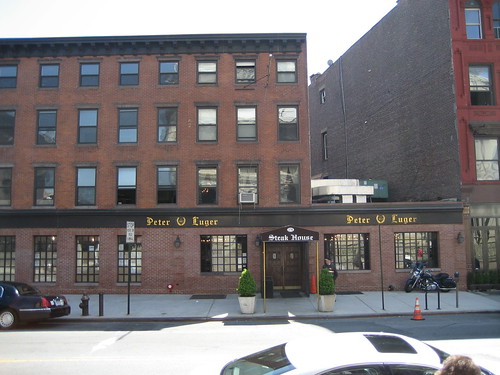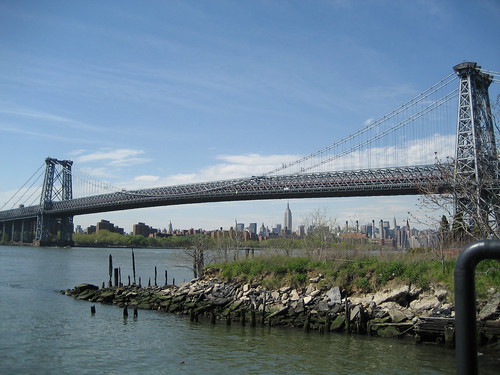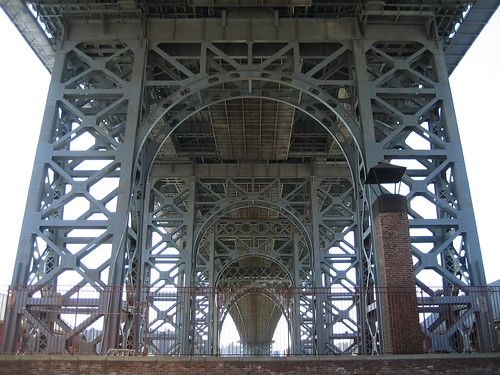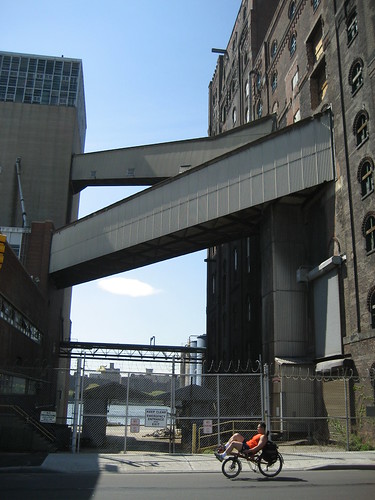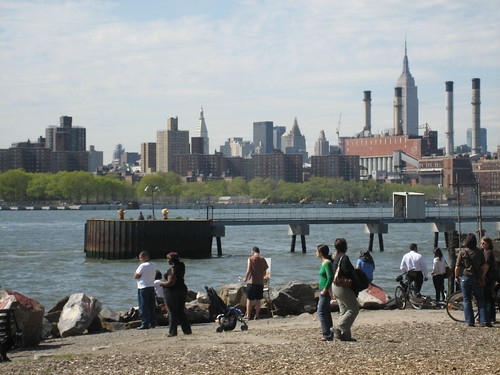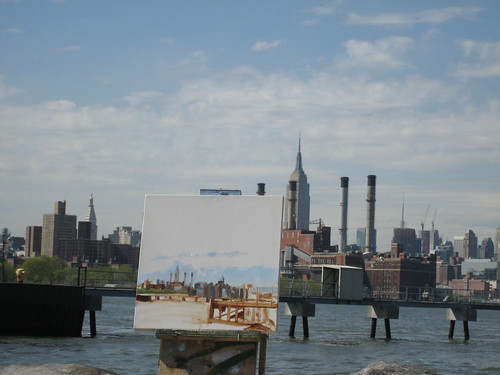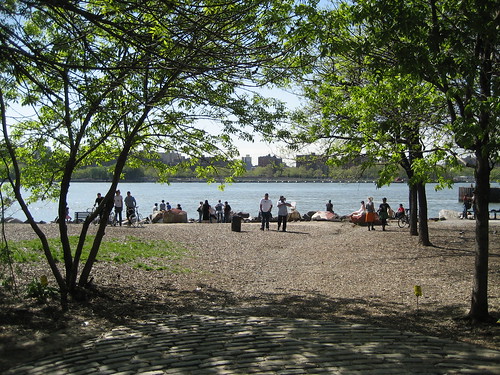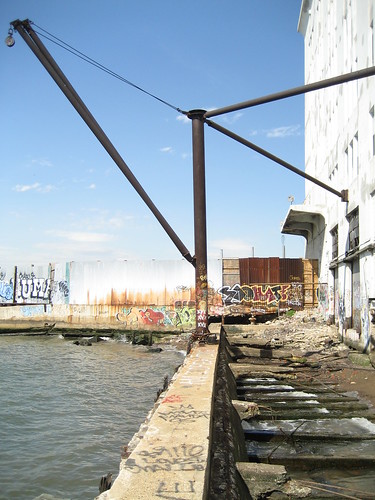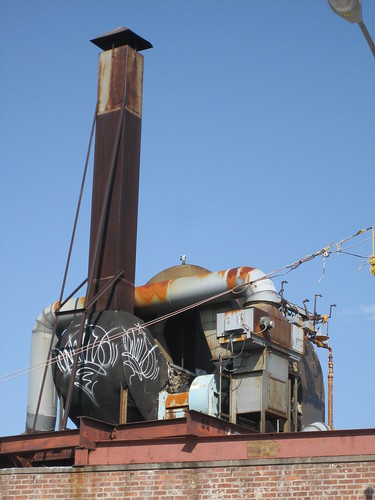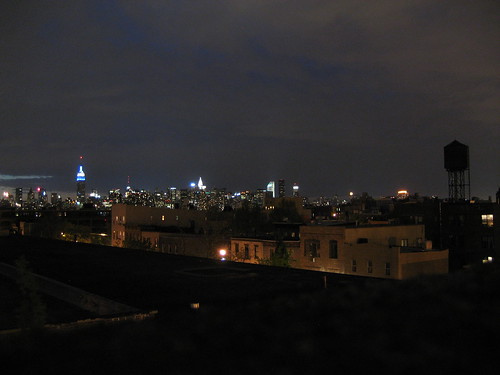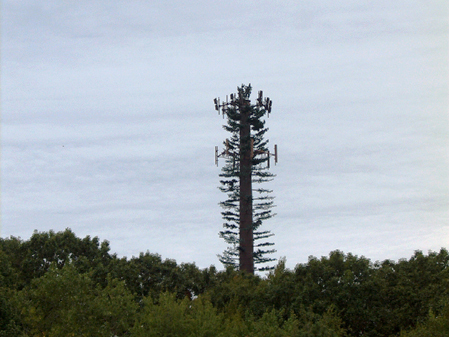ride to the sea
This week I fulfilled a long-time wish and rode my bike down Ocean Parkway to Coney Island.
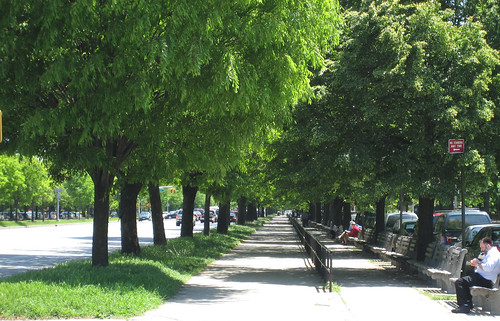 This tree-lined path starts just south of Prospect Park and continues about 5 miles until reaching the Atlantic Ocean. It's a lovely ride, if a bit bumpy.
This tree-lined path starts just south of Prospect Park and continues about 5 miles until reaching the Atlantic Ocean. It's a lovely ride, if a bit bumpy.
Culturally, the route was dominated by orthodox Jewish communities: it seemed that there was a Hebrew school or Synagogue on every block. The most unique of these buildings, from an architectural perspective, was the Mirrer Yeshiva, which seemed to have been redesigned mid-construction. At first glance, I thought that the school was adding a rooftop addition to take advantage of unused FAR, but closer examination revealed that the steel had been exposed for some time. I've never seen a building quite like it.
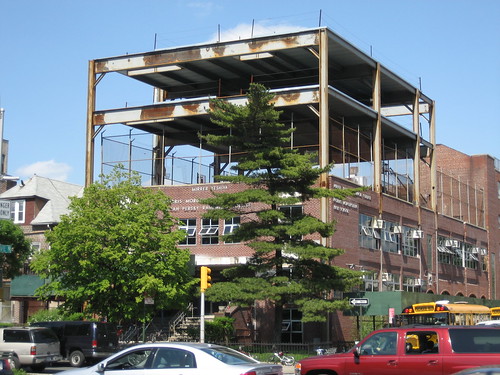 There are basketball courts on the roof of the brick structure below the two steel floors. Oy, what a design!
There are basketball courts on the roof of the brick structure below the two steel floors. Oy, what a design!
Ocean Parkway also passes several unique features of Brooklyn's built environment. In between Avenue H and Avenue I, for instance, the boulevard passes over the Bay Ridge Line, an underutilized freight line that once linked the piers of Sunset Park to a rail hub in western Brooklyn at Broadway Junction.
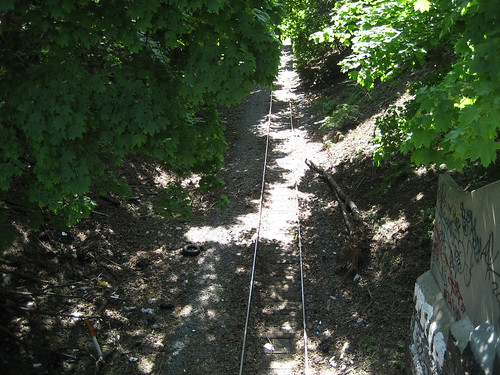 The Bay Ridge Freight Line.
The Bay Ridge Freight Line.
Several years ago at an old job, I examined the feasibility of re-using the Bay Ridge Line as a cross-Brooklyn light rail route. Adapting the right-of-way for light rail would be a relatively inexpensive way to link areas without transit service to existing subways.
Combined with other efforts, such transit improvements could spur substantial economic development in the area. Ultimately, however, the proposal was dropped from the final report I was working on. I still think it's a great idea.
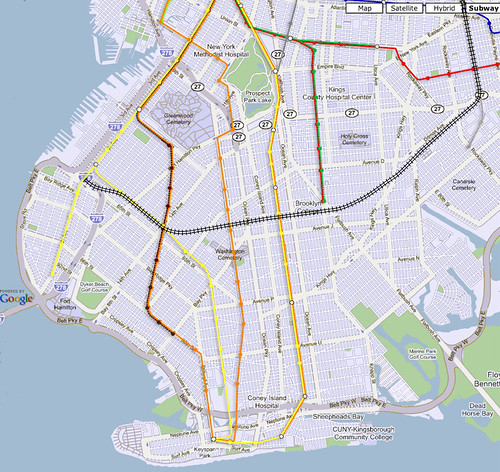 Brooklyn Google map with subways, via OnNYTurf. The Bay Ridge Line is the hatched double black line curving from east to west. The route of my ride, Ocean Parkway, is between the orange and yellow/orange lines in the center of the map.
Brooklyn Google map with subways, via OnNYTurf. The Bay Ridge Line is the hatched double black line curving from east to west. The route of my ride, Ocean Parkway, is between the orange and yellow/orange lines in the center of the map.
But back to the ride...
At Avenue U, in a landscape of single-family homes that bore little resemblance to the Brownstone Brooklyn I left at the start of my ride, I passed a mysterious cast-iron tower unlike any I'd ever seen in the city before. I wondered if it was perhaps a remnant of Brooklyn's once comprehensive trolley system, but found no evidence that Ocean Parkway ever had streetcars. As it turned out, the tower had a far less romantic origin.
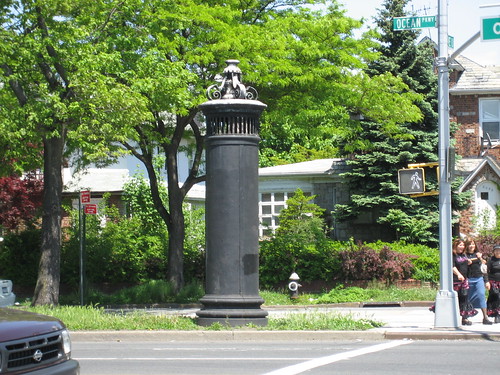 Obsolete sewer ventilation tower. Many thanks to Forgotten-NY's Kevin Walsh for the explanation.
Obsolete sewer ventilation tower. Many thanks to Forgotten-NY's Kevin Walsh for the explanation.
Finally, I reached Coney Island. The ocean was beautiful.
 Coney Island Boardwalk.
Coney Island Boardwalk.
On a whim, I departed from my plans and headed east, away from Coney Island. Before long I reached Brighton Beach, one of New York's classic Russian neighborhoods. The boardwalk wasn't crowded, and the few people I saw certainly weren't speaking English.
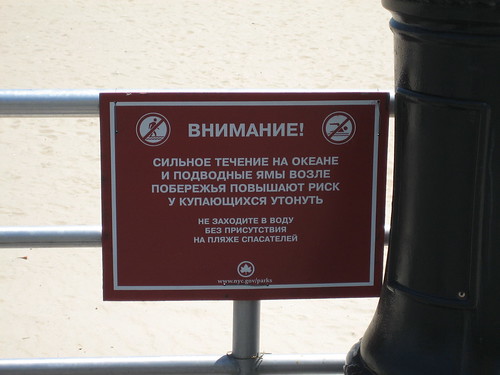 At least I could understand the URL at the bottom of the sign.
At least I could understand the URL at the bottom of the sign.
Eventually I made it to Kingsborough Community College, which has a beautiful campus at the entrance to Jamaica Bay. Across the water I saw Breezy Point, where I helped plan a marina that would have hosted sailing if New York had won its NYC2012 Olympic bid. I eyed the shore sadly, thinking about what an amazing venue it would have been.
Rounding the tip of the peninsula, I reached Sheepshead Bay, one of my favorite parts of the city. Besides City Island in the Bronx, Sheepshead Bay is the most 'New Englandy' part of New York City with active fishermen and a harbor filled with bobbing sailboats. (Check out the blog Sail Brooklyn for more about Sheepshead Bay.)
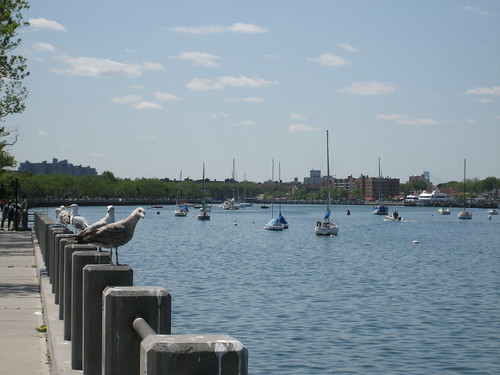 You can just see the top of the Verrazano Bridge in the distance.
You can just see the top of the Verrazano Bridge in the distance.
Riding slow to soak in the scenery, I was nonetheless going fast enough that an unseen speed bump flipped me neatly over my handlebars, almost ending my ride. Refusing medical attention from a startled security guard, a quick survey found my bike and body functional enough to continue -- my helmet had spared me a trip to the hospital. Bloodied but not beaten, I headed back to the beach.
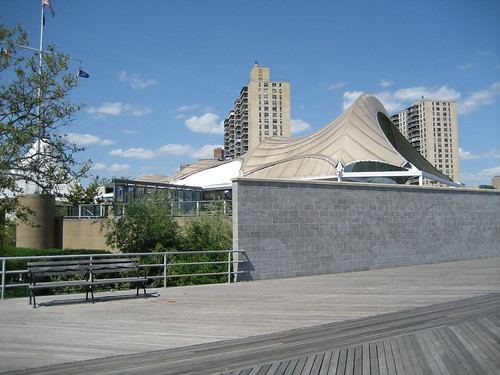 The New York Aquarium. Stupid place for a wall.
The New York Aquarium. Stupid place for a wall.
Back on the Coney Island boardwalk, I noticed the sorry state of the New York Aquarium, which was once located at Castle Clinton in Manhattan's Battery Park. Fortunately, the Aquarium is about to be rebuilt with a design by Enrique Ruiz-Geli, my favorite of a new crop of Catalonian architects transforming Spanish design.
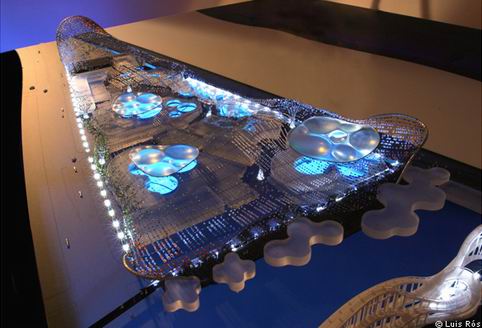 Ruiz-Geli's design for the New York Aquarium. (Via Gowanus Lounge)
Ruiz-Geli's design for the New York Aquarium. (Via Gowanus Lounge)
The new plan, which I love, interacts with the boardwalk much more than the existing building and has the potential to create a powerful waterfront-based aesthetic experience like that of the Milwaukee Art Museum, which was designed by Ruiz-Geli's Spanish compatriot Santiago Calatrava.
Further down the boardwalk, I felt conflicting emotions as I checked out Astroland in its final year of operation. On the one hand, I fear that new developments might destroy the kitschy charm that has given Coney Island its unique character for so long. On the other hand, I felt that some aspects of the boardwalk are ready to be retired. 'Shoot the Freak', for instance, which encourages children to fire paintballs at a 'live human target', is best left in the past.
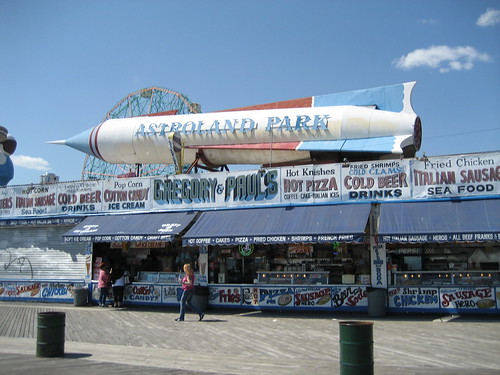 Astroland Park may be closing, but the world-famous Cyclone roller coaster will survive, thankfully.
Astroland Park may be closing, but the world-famous Cyclone roller coaster will survive, thankfully.
Heading back to Ocean Parkway and concluding my adventure for the day, I reflected that there was nowhere in the world quite like Brooklyn. I had seen but a thin slice of the borough on my bike ride, but witnessed a rich diversity of landmarks created by the people of the city. From temples and trains to roadways and restaurants, the environment of Brooklyn was one truly reflective of the broad range of people that live there.
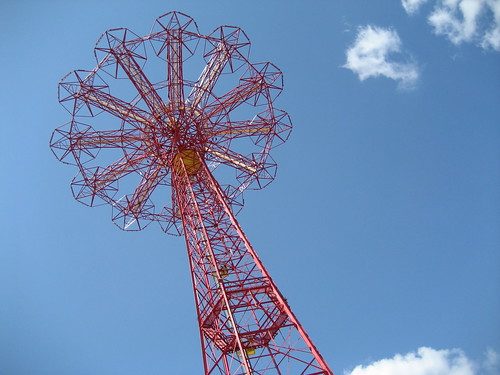 The Coney Island Parachute Jump.
The Coney Island Parachute Jump.
Sadly, I'm leaving Brooklyn soon to move west. It's tough to leave, but this unique city will always have a place in my heart. Will I miss Brooklyn? Yes. Will I remember it forever? Fugghedaboutit.
 This tree-lined path starts just south of Prospect Park and continues about 5 miles until reaching the Atlantic Ocean. It's a lovely ride, if a bit bumpy.
This tree-lined path starts just south of Prospect Park and continues about 5 miles until reaching the Atlantic Ocean. It's a lovely ride, if a bit bumpy.Culturally, the route was dominated by orthodox Jewish communities: it seemed that there was a Hebrew school or Synagogue on every block. The most unique of these buildings, from an architectural perspective, was the Mirrer Yeshiva, which seemed to have been redesigned mid-construction. At first glance, I thought that the school was adding a rooftop addition to take advantage of unused FAR, but closer examination revealed that the steel had been exposed for some time. I've never seen a building quite like it.
 There are basketball courts on the roof of the brick structure below the two steel floors. Oy, what a design!
There are basketball courts on the roof of the brick structure below the two steel floors. Oy, what a design!Ocean Parkway also passes several unique features of Brooklyn's built environment. In between Avenue H and Avenue I, for instance, the boulevard passes over the Bay Ridge Line, an underutilized freight line that once linked the piers of Sunset Park to a rail hub in western Brooklyn at Broadway Junction.
 The Bay Ridge Freight Line.
The Bay Ridge Freight Line.Several years ago at an old job, I examined the feasibility of re-using the Bay Ridge Line as a cross-Brooklyn light rail route. Adapting the right-of-way for light rail would be a relatively inexpensive way to link areas without transit service to existing subways.
Combined with other efforts, such transit improvements could spur substantial economic development in the area. Ultimately, however, the proposal was dropped from the final report I was working on. I still think it's a great idea.
 Brooklyn Google map with subways, via OnNYTurf. The Bay Ridge Line is the hatched double black line curving from east to west. The route of my ride, Ocean Parkway, is between the orange and yellow/orange lines in the center of the map.
Brooklyn Google map with subways, via OnNYTurf. The Bay Ridge Line is the hatched double black line curving from east to west. The route of my ride, Ocean Parkway, is between the orange and yellow/orange lines in the center of the map.But back to the ride...
At Avenue U, in a landscape of single-family homes that bore little resemblance to the Brownstone Brooklyn I left at the start of my ride, I passed a mysterious cast-iron tower unlike any I'd ever seen in the city before. I wondered if it was perhaps a remnant of Brooklyn's once comprehensive trolley system, but found no evidence that Ocean Parkway ever had streetcars. As it turned out, the tower had a far less romantic origin.
 Obsolete sewer ventilation tower. Many thanks to Forgotten-NY's Kevin Walsh for the explanation.
Obsolete sewer ventilation tower. Many thanks to Forgotten-NY's Kevin Walsh for the explanation.Finally, I reached Coney Island. The ocean was beautiful.
 Coney Island Boardwalk.
Coney Island Boardwalk.On a whim, I departed from my plans and headed east, away from Coney Island. Before long I reached Brighton Beach, one of New York's classic Russian neighborhoods. The boardwalk wasn't crowded, and the few people I saw certainly weren't speaking English.
 At least I could understand the URL at the bottom of the sign.
At least I could understand the URL at the bottom of the sign.Eventually I made it to Kingsborough Community College, which has a beautiful campus at the entrance to Jamaica Bay. Across the water I saw Breezy Point, where I helped plan a marina that would have hosted sailing if New York had won its NYC2012 Olympic bid. I eyed the shore sadly, thinking about what an amazing venue it would have been.
Rounding the tip of the peninsula, I reached Sheepshead Bay, one of my favorite parts of the city. Besides City Island in the Bronx, Sheepshead Bay is the most 'New Englandy' part of New York City with active fishermen and a harbor filled with bobbing sailboats. (Check out the blog Sail Brooklyn for more about Sheepshead Bay.)
 You can just see the top of the Verrazano Bridge in the distance.
You can just see the top of the Verrazano Bridge in the distance.Riding slow to soak in the scenery, I was nonetheless going fast enough that an unseen speed bump flipped me neatly over my handlebars, almost ending my ride. Refusing medical attention from a startled security guard, a quick survey found my bike and body functional enough to continue -- my helmet had spared me a trip to the hospital. Bloodied but not beaten, I headed back to the beach.
 The New York Aquarium. Stupid place for a wall.
The New York Aquarium. Stupid place for a wall.Back on the Coney Island boardwalk, I noticed the sorry state of the New York Aquarium, which was once located at Castle Clinton in Manhattan's Battery Park. Fortunately, the Aquarium is about to be rebuilt with a design by Enrique Ruiz-Geli, my favorite of a new crop of Catalonian architects transforming Spanish design.
 Ruiz-Geli's design for the New York Aquarium. (Via Gowanus Lounge)
Ruiz-Geli's design for the New York Aquarium. (Via Gowanus Lounge)The new plan, which I love, interacts with the boardwalk much more than the existing building and has the potential to create a powerful waterfront-based aesthetic experience like that of the Milwaukee Art Museum, which was designed by Ruiz-Geli's Spanish compatriot Santiago Calatrava.
Further down the boardwalk, I felt conflicting emotions as I checked out Astroland in its final year of operation. On the one hand, I fear that new developments might destroy the kitschy charm that has given Coney Island its unique character for so long. On the other hand, I felt that some aspects of the boardwalk are ready to be retired. 'Shoot the Freak', for instance, which encourages children to fire paintballs at a 'live human target', is best left in the past.
 Astroland Park may be closing, but the world-famous Cyclone roller coaster will survive, thankfully.
Astroland Park may be closing, but the world-famous Cyclone roller coaster will survive, thankfully.Heading back to Ocean Parkway and concluding my adventure for the day, I reflected that there was nowhere in the world quite like Brooklyn. I had seen but a thin slice of the borough on my bike ride, but witnessed a rich diversity of landmarks created by the people of the city. From temples and trains to roadways and restaurants, the environment of Brooklyn was one truly reflective of the broad range of people that live there.
 The Coney Island Parachute Jump.
The Coney Island Parachute Jump.Sadly, I'm leaving Brooklyn soon to move west. It's tough to leave, but this unique city will always have a place in my heart. Will I miss Brooklyn? Yes. Will I remember it forever? Fugghedaboutit.
